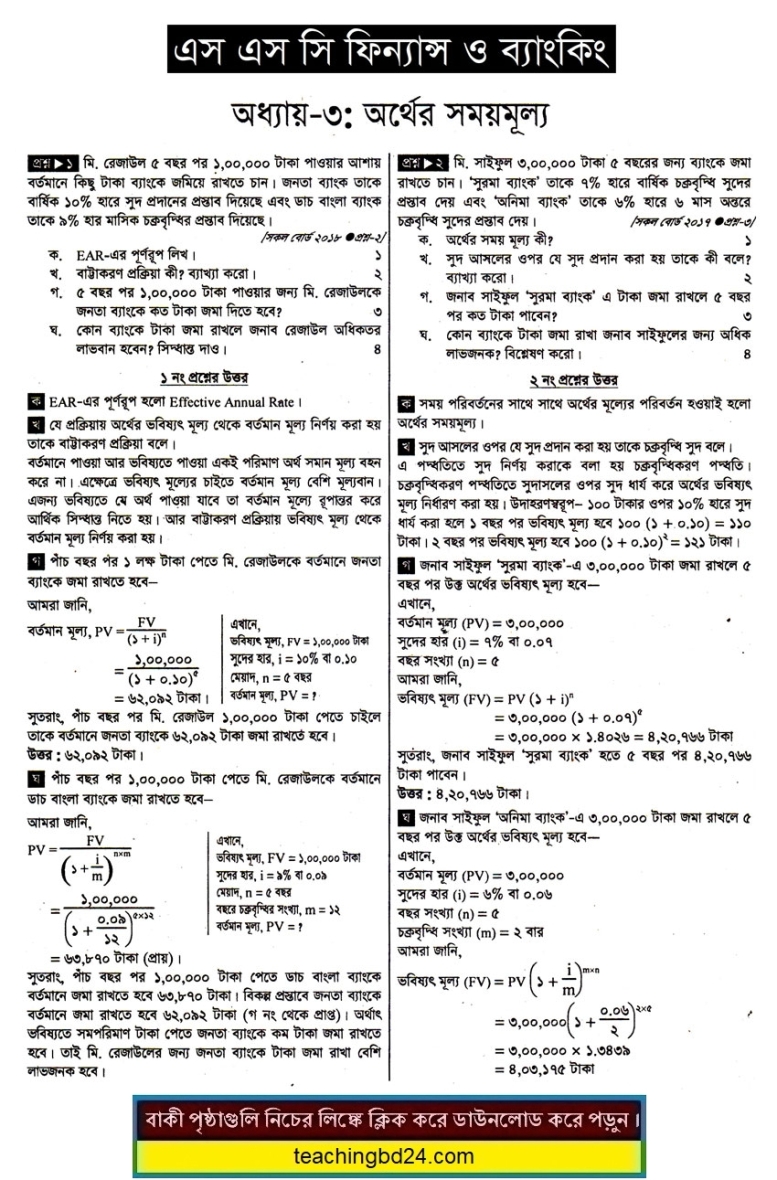Chapter 3. Time Value of Money
Chapter 3. Time Value of Money. The concept of Time Value of Money is the root of all Financial Decision. Today’s Tk100.00 and Tk100.00 after 10 years will not carry the same value. This concept of time value is also necessary for our daily life. If we know by what rate he is calculating the interest of the loan taken from the moneylender, we will be able to evaluate among different sources and we can compare different sources before making any financial decision.
This way we can finance from most suitable sources. A loan taken from the bank requires paying installment as per the payment schedule. How this payment schedule is being measured – this chapter will also cover this kind of mathematical problem. To solve these mathematical problems, a scientific calculator will be needed. But you cannot use a financial calculator.
Chapter 3. Time Value of Money


The fund required for the purpose of starting any business or to conduct the daily activities of the business, selection of the sources of finance is one of the important decisions in financial management. Because different sources have different costs of capital and the sources of different terms have different advantages and disadvantages. An institution collects funds by analyzing different sources to select that mixture of sources which will provide maximum benefit and minimum cost. The main objective of the investment is profit earning. We can get net profit by subtracting the cost of capital and tax from the total profit. So, the cost of capital should be reduced to maximize the profit of the business.
Sourcing money may be done for a variety of reasons. Traditional areas of need may be for capital asset acquirement – new machinery or the construction of a new building or depot. The development of new products can be enormously costly and here again, capital may be required. Normally, such developments are financed internally, whereas capital for the acquisition of machinery may come from external sources. In this day and age of tight liquidity, many organizations have to look for short term capital in the way of overdraft or loans in order to provide a cash flow cushion. Interest rates can vary from organization to organization and also according to the purpose.
Chapter objectives
This chapter is intended to provide:
- An introduction to the different sources of finance available to management, both internal and external
- An overview of the advantages and disadvantages of the different sources of funds
- An understanding of the factors governing the choice between different sources of funds.
Structure of the chapter
This final chapter starts by looking at the various forms of “shares” as a means to raise new capital and retained earnings as another source. However, whilst these may be “traditional” ways of raising funds, they are by no means the only ones. There are many more sources available to companies that do not wish to become “public” by means of share issues. These alternatives include bank borrowing, government assistance, venture capital, and franchising. All have their own advantages and disadvantages and degrees of risk attached.
Ordinary shares are issued to the owners of a company. They have a nominal or ‘face’ value, typically of $1 or 50 cents. The market value of a quoted company’s shares bears no relationship to their nominal value, except that when ordinary shares are issued for cash, the issue price must be equal to or be more than the nominal value of the shares.
teachingbd24.com is such a website where you would get all kinds of necessary information regarding educational notes, suggestions and questions’ patterns of school, college, and madrasahs. Particularly you will get here special notes of physics that will be immensely useful to both students and teachers. The builder of the website is Mr. Md. Shah Jamal Who has been serving for 30 years as an Asst. Professor of BAF Shaheen College. He expects that this website will meet up all the needs of Bengali version learners /students. He has requested concerned both students and teachers to spread this website home and abroad.

